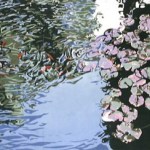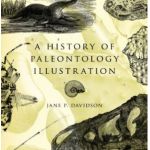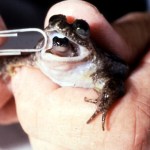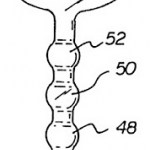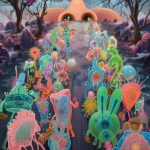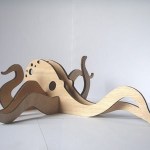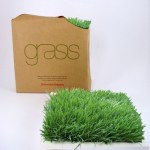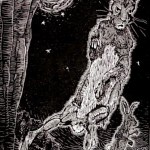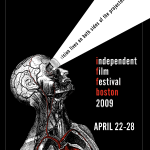
Circling Around, 2008
Jean Gumpper
Jean Gumpper's woodcut prints are mesmerizing. At first glance, the crisp edges and intricate detail are reminiscent of watercolor. But the works are actually pieced out of flat spots of block color, which gives them a stylized, minimalist, modern flavor - like gallery-quality IKEA. The final effect is one I've sometimes seen in quilts: the flatness of the colors and starkness of the edges combine to generate a sparkle and clarity in the complete piece, an illusion of motion through a brightly lit space.
From the artist's statement:
In my work as an…
I promised you some updates on the Google Books Settlement, so here you go. Things are definitely getting interesting.
First, I mentioned earlier that I was going to attend a panel on the Google Book Search Settlement here in DC, featuring representatives of Google, the publishers, and the Internet Archive. ITIF, which organized the panel, has made the entire thing available online; I've linked to it at the bottom of the post, because it's over an hour long.
Anyway, it was interesting to hear the (very civil) differences of opinion between Dan Clancy, the Engineering Director for Google Book…
Let etsy seller foliage help you fight swine flu with this bagful of handmade soaps in "skin-ish colors"!
I vascillate between finding them cute, and thinking they resemble a crowd of damned souls reaching out for help from my soap dish. Weird.
Dedicated to John O., who truly appreciates disembodied hands. Via DailyArtMuse.
Mark Buchanan, quoting Lee Smolin, on how big science may be biased against innovative iconoclasts:
Some scientists, he suggests, are what we might call "hill climbers". They tend to be highly skilled in technical terms and their work mostly takes established lines of insight that pushes them further; they climb upward into the hills in some abstract space of scientific fitness, always taking small steps to improve the agreement of theory and observation. These scientists do "normal" science. In contrast, other scientists are more radical and adventurous in spirit, and they can be seen as "…
Check out Brian's new review of A History of Paleontology Illustration (Life of the Past) by Jane Davidson, in Palaeontologia Electronica:
It is rare for fossils to be featured in fine art, but in the 15th century painting A Goldsmith in His Shop, Possibly Saint Eligius by the Flemish master Petrus Christus there is, if you look carefully, a fossil shark tooth among the objects scattered on the shop's table. The fossil plays a nearly insignificant role in the painting, but it reflects the general interpretation of such natural curiosities at the time. From this modest starting point,…
How much more successful would Gravity's Rainbow have been if it were two paragraphs long and posted on a blog beneath a picture of scantily clad coeds? And why not add a Google search box?
Want to become a high-profile Twitter superstar? McSweeney's tells you exactly how. Maybe Google is making everyone stupid, but if so, the bar for a successful writer is now much lower! w00t!
Just as an FYI, Sheril at the Intersection has created this extremely helpful list of policy fellowships for scientists and engineers. It's definitely worth bookmarking if you have any interest in exploring science policy. The fellowships on this list range from weeks to years, and placements are available throughout the federal government, in science agencies and on the Hill.
Birth of the Gastric Brooding Frog
Photo Mike Tyler
Unfortunately, species are the ultimate bioephemera.
Amphibians in particular have been declining at an alarming rate over the past several decades; some estimates suggest that a third of amphibian species are on the verge of extinction. My latest essay for SEED's website opens with the story of the Gastric Brooding Frog, Rheobatrachus silus, an extremely peculiar species. It was discovered in the 1970s, and already believed extinct just over a decade later. That's barely enough time to describe a species, much less save it.
Save the Frogs…
I'm off to visit the Supreme Court tomorrow, so I thought I'd share some law news for a change. In a landmark patent decision, Federal Circuit Judge Richard Posner has ruled that the sex toy shown above is "obvious."
You can read the explanation at Patently-O, but suffice it to say that the gap between the legal sense of the word "obvious" and its colloquial sense may be as wide as the gap for "theory" (as in, "but evolution is just a theory.") Honestly, I would not have known this was a sex toy if I hadn't been told. It looks like a bottle opener. Perhaps the dry design schematic leaches…
Simple, but surprisingly charming - and somewhat reminiscent of an ant colony or other biological collective:
Fluid Sculpture (click for larger video) from Charlie Bucket on Vimeo.
An interesting perspective from today's WaPo: David Kessler, doctor, lawyer, and former FDA commissioner, argues that the food industry manipulates the neurological impacts of fats and sugars to program consumers to eat more than we need or want.
"The food the industry is selling is much more powerful than we realized," he said. "I used to think I ate to feel full. Now I know, we have the science that shows, we're eating to stimulate ourselves. And so the question is what are we going to do about it?"
Read more about Kessler's Dumpster-diving quest to prove his point here. Kessler's new book…
This air purifier ad from Sharp is a little creepy, in a Spongebob Squarepants way. I love how you can see their fluorescent organelles! Unfortunately I don't see anything here that resembles a virus, but with swine flu all over the news, this serves as a good reminder to wash your hands.
Ad by Takho Lau for ad agency M&C Saatchi of Hong Kong. Found via Next Nature
One of the sucky things about viral interest in offbeat art from small vendors is that it always immediately depletes the supply. Like this fabulous minimalist plywood octopus from inthewoods' etsy shop. Sure, you can still get a plywood squirrel with a plywood acorn, but where's the sinister, feverish Cthulhulian majesty in that? Frustrated now!
Via monoscope
Check out this concept artwork called "Office Grass". What is it good for? Well, for one thing, to patch its apparently coincidental inverse artwork, "Dead Pixel in Google Earth:"
Christmas greeting card, school unknown, circa 1920.
Dittrick Medical History Center
from Dissection: Photographs of a Rite of Passage in American Medicine 1880-1930
Slate has an intriguing new review by Barron Lerner of a book called Dissection: Photographs of a Rite of Passage in American Medicine 1880-1930, by John Harley Warner and James M. Edmonson. The book delves into the turn-of-the-century practice of photographing medical students with cadavers - photos that today read as weird, grotesque, even offensive.
The photos unearthed by Warner and Edmonson depict an astonishing variety of…
Levitations
Johanna Mueller, 2004
Artists I'm looking forward to seeing at the 10th annual Artomatic, #1: printmaker Johanna Mueller, whose woodcuts resemble the illustrations from a dark and hallucinogenic children's book. No wonder her blog is called "Feverish Art."
The Independent Film Festival Boston kicked off today, and this was their ad campaign. Nice use of anatomical imagery!
Light is an ephemeral but powerful artistic medium. This commercial for the Belgian energy company Electrabel captures the whimsical charm of fireflies on a warm summer night:
You can view a stunning higher-res version of this video here, with slightly different music. There is also a making-of video with scenes of the film shoot.
Thanks to Rhett for finding this one!
We all know Twitter can be annoying, but is it really evil? During the past week, you may have heard that there is brand-new neuroscientific evidence proving exactly that. But the hype turns out to be just that: hype.
It all started with a press release from USC about an upcoming PNAS paper by Mary Helen Immordino-Yang and Antonio Damasio, entitled "Neural Correlates of Admiration and Compassion." The USC press release, which was picked up by EurekAlert and other outlets, says:
The finding, contained in one of the first brain studies of inspirational emotions in a field dominated by a focus…
C.P. Snow fans, prepare to head over to the Intersection to partake in an upcoming online discussion of Snow's famous "Two Cultures" address. In their new article, "The Culture Crosser," Sheril and Chris portray Snow as a sort of science policy prophet:
It helps to think of Snow as an early theorist on a critical modern problem: How can we best translate highly complex information, stored in the minds of often eccentric (if well meaning) scientists, into the process of political decision making at all levels and in all aspects of government, from military to medical? At best that's a…
